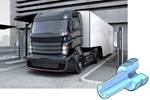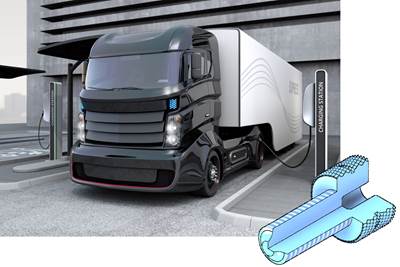AZL announces follow-up projects on electromobility casings, thermal runaway
AZL continues series of projects to develop the next generation of battery casings for electromobility, encourages interested companies to join consortias before Sept. 11th kick-off.
From its previous cooperation with a total of 79 project partners, the AZL Aachen (Aachen, Germany) network has defined two follow-up projects that deal with casing design for future cell technologies and methods for simulating thermal and mechanical loads in a thermal runaway event. The projects, “Emerging Battery Storage Technologies” and “Thermal Propagation in BEV Battery Casings,” aim to improve the design and selection of construction methods as well as the development process of battery casings. Interested companies can join the two consortia — including Audi AG, Magna Steyer Fahrezugtechnik GmbH & Co. KG, Posco and Syensqo, among others — up until the kick-offs on Sept. 11, 2024.
The first project, “Emerging Battery Storage Technologies,” focuses on the design and requirements of battery casings and how these aspects will change in the course of future battery technologies. There are continuous innovations in the field of cell chemistry. The cell configuration, and in particular the cell chemistry, has a major influence on the design of battery casings, both in terms of size and temperature control during normal operation as well as the level of protection required in disruptive events such as accidents and thermal runaway.
“The new project is a logical development of our previous initiatives and aims to provide valuable insights into the future of battery case design,” says Warden Schijve, design leader and expert in battery casing development at AZL Aachen GmbH. “By analysing the properties of new battery chemistries in terms of their influence on housing design and extending the scope to different vehicle types, the project will provide comprehensive insights for stakeholders along the entire value chain regarding the future competitiveness of different material, design and production concepts.”
The project will include a market and technology analysis of different cell technologies, requirement for different vehicle types beyond cars, as well as the development of design concepts and cost-benefit analyses of casing concepts. Participants will gain valuable insights into the competitiveness of casing designs based on steel, aluminium, plastics and multi-material designs.
The second of the two projects, “Thermal Propagation in BEV Battery Casings,” deals specifically with the question of how the loads that actually occur in the event of thermal runaway can be predicted more accurately and how cell and casing behaviour can be further improved.
“The high thermal and pressure loads in the event of thermal runaway place very high demands on the selection of materials for the structure of battery housings,” explains Philipp Fröhlig, head of industrial services at AZL Aachen GmbH. “Our aim is to predict in the early development phases how battery casings will behave in the event of thermal runaway depending on the cell types and pack design and whether the safety requirements are met. This should save time and costs by reducing test campaigns and enable a better evaluation of material concepts.”
The project is divided into three phases. The basis is a comprehensive analysis of the time sequence, the loads, the influence of cell characteristics and suitable models relating to thermal runaway. Subsequently, methods of analysis are developed and evaluated that enable the prediction of loads for integration into CAE analyses for component development. Finally, guidelines for the application of the method are provided.
Participation is now possible
The new “Joint Partner Projects” will start on Sept. 11, 2024 and interested companies have the opportunity to join the consortia until then. Participants can address their specific interests and thus help steer the 9-month projects to a certain extent. The regular project meetings also offer company representatives a platform to network with allied companies, make new business contacts and obtain interesting information from the market through direct dialogue.
One of the already confirmed partners is Audi AG. The company’s Dr. Florian Meyer, head of development in CAE simulation for bodyshells, says, “We have participated in four of AZL’s Joint Partner Project related to designing of plastic battery casings and developing application-oriented testing methods. We made valuable contacts for our supply chain and enriched our understanding on potentials of various material options. From the new starting projects, we expect valuable contributions to our advanced CAE-methods and also insights into effects of emerging battery storage technologies on the design of battery casings.
Related Content
SMC composites progress BinC solar electric vehicles
In an interview with one of Aptera’s co-founders, CW sheds light on the inspiration behind the crowd-funded solar electric vehicle, its body in carbon (BinC) and how composite materials are playing a role in its design.
Read MoreJeep all-composite roof receivers achieve steel performance at low mass
Ultrashort carbon fiber/PPA replaces steel on rooftop brackets to hold Jeep soft tops, hardtops.
Read MoreMcLaren celebrates 10 years of the McLaren P1 hybrid hypercar
Lightweight carbon fiber construction, Formula 1-inspired aerodynamics and high-performance hybrid powertrain technologies hallmark this hybrid vehicle, serve as a springboard for new race cars.
Read MoreRecycling hydrogen tanks to produce automotive structural components
Voith Composites and partners develop recycling solutions for hydrogen storage tanks and manufacturing methods to produce automotive parts from the recycled materials.
Read MoreRead Next
Composites end markets: Batteries and fuel cells (2024)
As the number of battery and fuel cell electric vehicles (EVs) grows, so do the opportunities for composites in battery enclosures and components for fuel cells.
Read MoreArcher completes installation of high-volume battery pack manufacturing line
“Automotive-style” line has the capability of producing up to 15,000 battery packs — complete with composite enclosures and cylindrical cells — per year to keep up with eVTOL aircraft production goals.
Read MoreCreating a composite battery insert-stud solution for EV trucks
Bossard worked with an OEM and Tier supplier team to meet tight electrical insulation and packaging tolerances while reducing tooling, molding and assembly costs.
Read More



























